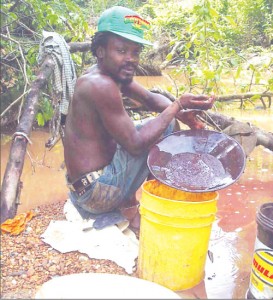Even as rising world market prices for gold trigger a frenetic gold rush in Guyana’s hinterland region, a vigorous international lobby for safer mining practices may force fundamental changes in local operations.
At last month’s Guianas mining forum hosted by the World Wildlife Fund (WWF) it was revealed that environmental lobbyists are gradually closing in on the use of mercury in the mining sector, vigorously promoting alternative processing practices that eschew the use of the highly toxic chemical.

The most devastating effect of mercury is the toxicity produced by methyl mercury which can manifest itself at low levels. Mercury also accumulates in rivers, creeks and ocean sediment, where it is transformed into methyl mercury which usually accumulates in fish tissue. This form of mercury pollution causes the most serious health and environmental harm since it is widely present in ocean and lakes and builds up in predator fish at the top of the aquatic food chain and in shell fish in all parts of the world. The mercury levels of these fishes can be millions of times higher that the levels in surrounding water.
The impact of mercury poisoning is also thought to be severe among small-scale miners – and children – in developing countries where millions of miners use the liquid metal to separate gold. Mercury also contaminates land and waterways where gold is extracted. In addition, mercury is released into the atmosphere when gold-mercury amalgam is heated, often in open pans, to release the precious metal. The impact of mercury poisoning in fish on food supplies in host communities in some mining areas has long been the subject of vigorous protest among Amerindian and other lobbyists.
A lobby for an international ban on the use of mercury in the mining sector has already taken shape in Europe where the European Union agreed on June last year on a ban on exports of mercury from the 27-nation bloc from July 2011. Additionally, the EU has agreed to establish guidelines for the safe storage of mercury once the ban comes into effect.
A ban on mercury exports by EU countries – the EU produces around 1,000 tons of the total global annual supply of about 1,000 tons – could impact significantly on supplies to developing countries.
Meanwhile, the United States has also moved to impose a ban on the export of elemental mercury beginning U.S. in 2010 under legislation approved by a House of Representatives panel on Oct. 30, 2007. The measure is designed to help stem the flow of commodity-grade mercury from industrialized countries to the developing world.
While the Guyana Geology and Mines Commission (GGMC) is on record as an advocate of safer mining practices including more responsible use of mercury, the limited policing capacity of the agency restricts its ability to determine practices on the ground. What is known is that rising gold prices and the attendant gold rush has coincided with some major incidents of mining activity that is hostile to the environment. The Guyana Gold and Miners Association (GGDMA) which has spoken out against other environmentally unsound practices in the mining sector has not taken a similarly robust position on the use of mercury in the mining sector.
At last month’s forum on mining in the Guianas where miners, mining administrators and environmental experts from the Guianas (Guyana, Suriname and French Guiana) Brazil, Canada and Colombia met to discuss the application and possible adoption of more responsible mining techniques and to develop a network for the sharing of information the question of mercury use arose without the forum arriving at any concrete conclusion on the future of mercury use in the gold mining sector. With the charge for the ban on mercury use being led by the world’s leading producers, however, Guyana – and the rest of the Guianas – may have little choice but to eventually fall in line with a growing body of global opinion that appears to have concluded that the dangers posed by mercury use in the mining sector have now become far too great to be ignored any longer.

